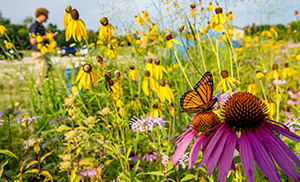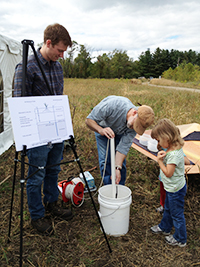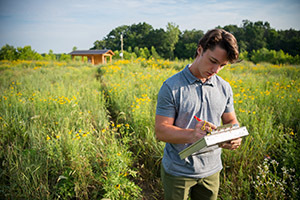
Zach Hanson, a civil engineering graduate student, likes the days when he leaves the lab at Notre Dame, laces up his boots and drives ten minutes north to St. Patrick’s County Park to collect his newest batch of data on groundwater recharge from his 13 well array.
“It’s so nice to spend a day outside working. I get back in touch with the environment, which is the whole motivation behind my work.”
Often he’ll spot an eagle flying overhead. Near his well array live the first pair of bald eagles to nest successfully in St. Joseph County in recorded history.
 Professor Alan Hamlet and Zach Hanson demonstrate their research to area children on Science Sunday.
Professor Alan Hamlet and Zach Hanson demonstrate their research to area children on Science Sunday.
This is Notre Dame’s Linked Environmental Ecosystem Facility (ND-LEEF), a 29-acres property with two replicate watersheds, consisting of ponds, streams, and wetlands and acres of native grasses. The facility houses collaborative experiments that are bringing researchers together across disciplines to conduct critical climate and land-use change research. Professor Alan Hamlet believes this facility has a lot of potential to produce climate impact assessments and research strategies for successful adaptation.
Studies to date include testing the reliability of groundwater recharge models that are deployed for climate change research across the country, studying the transport of nutrients, yeast, pollen and eDNA in freshwater systems, testing the effectiveness of new low-cost snow sensors that could in the future be deployed for climate studies in the tundra, and many others.
Professor Diogo Bolster, Director of ND-LEEF, explains that the facility fills an important research niche by helping to close the field-lab dichotomy, “We do so many experiments in the lab and then people go and do measurements in the field. What you find time and time again is that the measurements you took in the lab don’t match the measurements you take in the field. You have a scaling issue.”
Typically in the field setting, researchers lose too much control. It is hard to truly test hypotheses because you cannot fully isolate mechanisms. ND-LEEF, by being a highly controlled field-site, is the sweet spot in between the small, controlled laboratory scale and a real stream, real watershed, real pond, real lake system.
Bolster elaborates, “We know the characteristics that are there because we built it — Professor Tank, six students, and I were literally out there with shovels. We know exactly the design parameters, we know the flow rates exactly, we know the water quality that’s going in, in fact we have the ability to control many of those things.”
 Researcher collects data in front of ND-LEEF’s Morrison Pavilion.
Researcher collects data in front of ND-LEEF’s Morrison Pavilion.
In addition to closing the field-lab dichotomy, ND-LEEF is building collaborative bridges between different disciplines. Large-scale environmental problems, such as climate change, can only be successfully combated through these types of interdisciplinary collaborations. These bridges, according to Bolster, are perhaps the greatest success of the project.
The strongest relationship forged to date has perhaps been between biology and engineering. Professor Jennifer Tank, from Notre Dame’s biology department, whose research focuses on the effects of human activities on freshwater ecosystems, was one of the primary driving forces behind establishing ND-LEEF and served as its founding director.
Bolster admits that at first it was sometimes hard to work across disciplines. Engineers and biologists speak two different languages, so they had to learn to communicate and build a common language to discuss their ideas and their research, but now that those connections have been made the opportunities feel nearly limitless and the ND-LEEF team has big dreams for their facility, such as expanding from two to ten replicate watersheds and collaborating with architecture professor Aimee Buccelatto to build a green satellite campus at the facility using cutting edge sustainable design techniques.
The facility is not simply used for research, it is becoming an educational hub for people of all ages to connect to the land and learn about ecology and environmental concerns. You’re apt to find all sorts of people at ND-LEEF’s Morrison Pavilion from hikers learning about the facility through interactive educational videos to Notre Dame ecology or hydrology classes engaging in experiential education to local high school chemistry students participating in a research project on phosphorous. Assistant Director Brett Peters is often at the facility giving tours to teachers, naturalists and the general public.
Bolster concluded, “The opportunities are endless. We want people from other universities to use it. We want people not just from our department and biology. Anybody who has an idea, anybody who wants to test something. We’re only limited by what we can imagine. There is no facility exactly like ND-LEEF anywhere else in the world.”
Originally published by Marijke Wijnen at ceees.nd.edu on March 31, 2017.
Originally published by at environmentalchange.nd.edu on April 04, 2017.